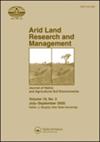Physiological and biochemical properties of wheat (Triticum aestivum L.) under different mulching and water management systems in the semi-arid region of Punjab, Pakistan
IF 1.6
4区 农林科学
Q3 ENVIRONMENTAL SCIENCES
引用次数: 6
Abstract
Abstract In order to meet the dietary requirements of the rising human population with diminishing water resources, there is the need to adopt techniques that optimize crop yield under reduced water conditions. Therefore, a greenhouse experiment was carried out to determine the effect of mulching and reduced irrigation on wheat production. The experiment included four mulching treatments (un-mulched, black plastic sheet mulch, wheat straw mulch and cotton sticks mulch) and two watering regimes (normal watering and partial root-zone drying irrigation (PRI) technique that involves alternate watering to only one side of root zone only) arranged in a completely randomized design. Wheat growth (leaf area index, plant height), water related parameters (leaf relative water contents (RWC), leaf turgor potential and physiological (chlorophyll contents, stomatal oscillation and photosynthetic rate) parameters and biochemical indicators were significantly higher with mulching than un-mulched for both irrigation levels. However, among the mulching treatments, the use of black plastic mulch gave the best results. Among the mulch treatments, RWC increased by 4.29%, 7.50% and 10.73% with black plastic mulch compared to wheat straw mulch, cotton stick mulch and control treatment, respectively. Between the two irrigation levels, higher wheat growth, physiological and water related parameters were found with full irrigation. Whereas leaf osmotic potential, quality traits and antioxidant enzymatic activities were higher with PRI. This study shows that, particularly with black plastic film, mulching combined with partial root zone drying can be effectively used in conserving soil water, thus increasing crop water use, photosynthetic rate, and yield.巴基斯坦旁遮普半干旱区不同覆盖和水分管理制度下小麦的生理生化特性
在水资源日益减少的情况下,为了满足不断增长的人口对饮食的需求,有必要采用在缺水条件下优化作物产量的技术。为此,通过温室试验,确定了覆盖和减少灌溉对小麦产量的影响。实验包括四种覆盖处理(未覆盖、黑塑料板覆盖、麦秸覆盖和棉条覆盖)和两种浇水方式(正常浇水和部分根区干燥灌溉(PRI)技术,只在根区一侧交替浇水),这些都是完全随机设计的。在两种灌溉水平下,覆盖小麦的生长(叶面积指数、株高)、水分相关参数(叶片相对含水量(RWC)、叶片膨压势)和生理参数(叶绿素含量、气孔振荡和光合速率)及生化指标均显著高于未覆盖小麦。在不同覆盖处理中,以黑色地膜覆盖效果最好。覆盖处理中,黑塑覆盖比麦秸覆盖、棉条覆盖和对照处理分别提高了4.29%、7.50%和10.73%的RWC。在两个灌溉水平之间,全灌条件下小麦生长、生理和水分相关参数较高。而PRI处理的叶片渗透势、品质性状和抗氧化酶活性较高。本研究表明,特别是在黑色地膜下,覆盖结合部分根区干燥可以有效地保持土壤水分,从而提高作物水分利用率、光合速率和产量。
本文章由计算机程序翻译,如有差异,请以英文原文为准。
求助全文
约1分钟内获得全文
求助全文
来源期刊

Arid Land Research and Management
环境科学-环境科学
CiteScore
3.80
自引率
7.10%
发文量
23
审稿时长
9 months
期刊介绍:
Arid Land Research and Management, a cooperating journal of the International Union of Soil Sciences , is a common outlet and a valuable source of information for fundamental and applied research on soils affected by aridity. This journal covers land ecology, including flora and fauna, as well as soil chemistry, biology, physics, and other edaphic aspects. The journal emphasizes recovery of degraded lands and practical, appropriate uses of soils. Reports of biotechnological applications to land use and recovery are included. Full papers and short notes, as well as review articles and book and meeting reviews are published.
 求助内容:
求助内容: 应助结果提醒方式:
应助结果提醒方式:


